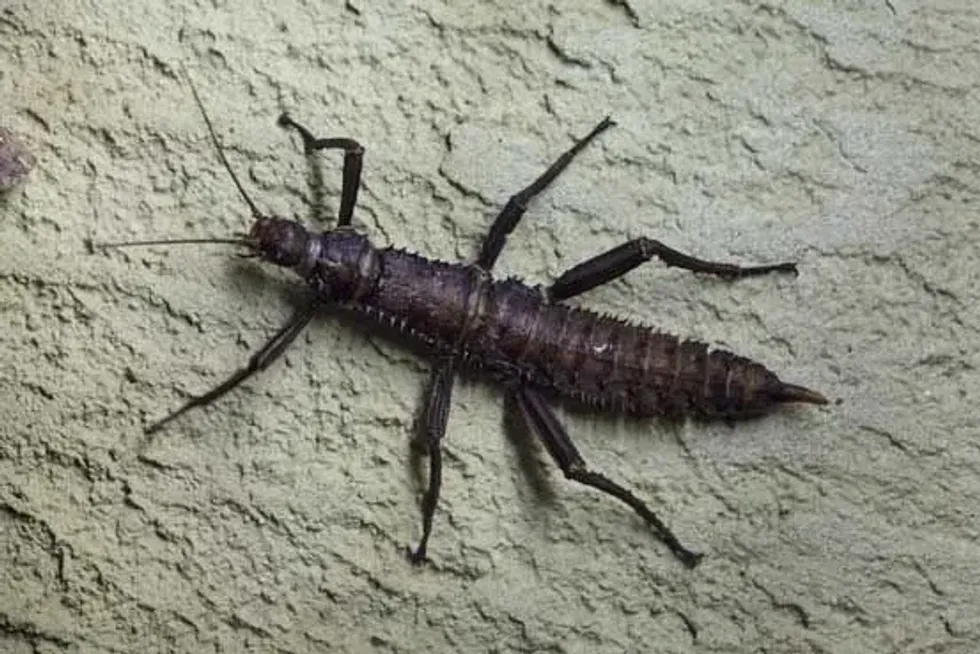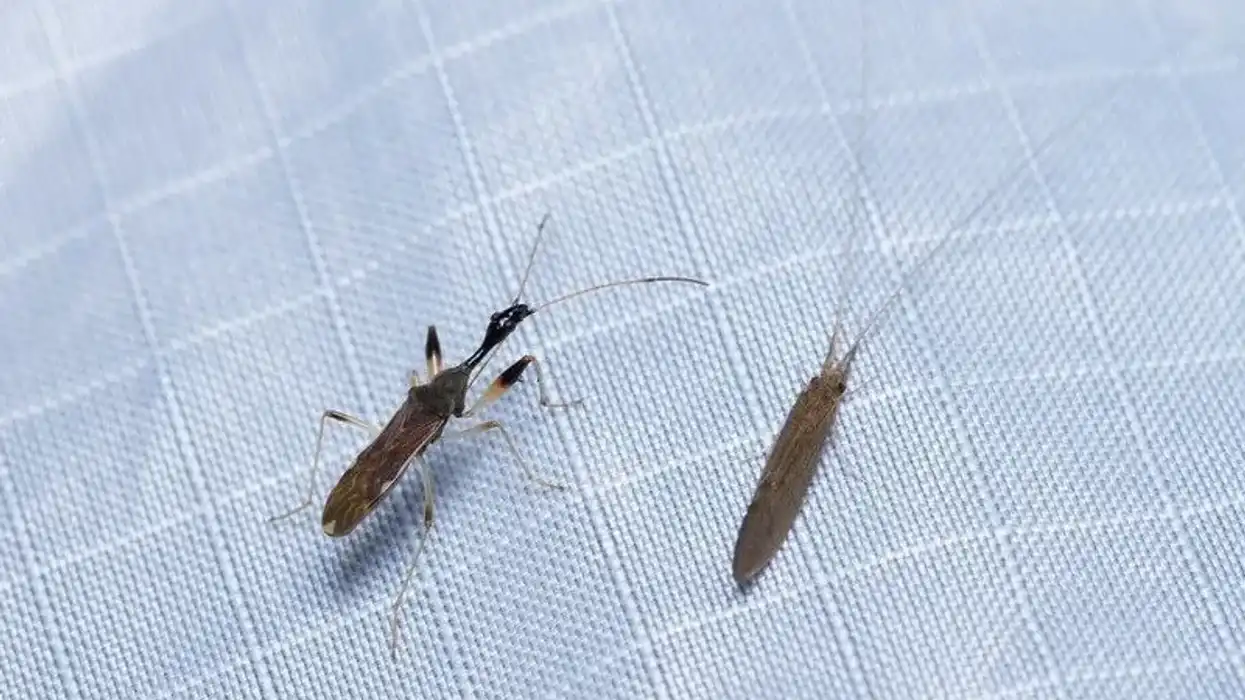The Lord Howe Island stick insect, also known as tree lobster, is a stick insect species that primarily lives on the Lord Howe Island Group. Its scientific name is Dryococelus australis and it is the only member of Dryococelus, the monotypic genus.
On Lord Howe Island, they were used as bait for fishing. But, after the SS Makambo supply ship ran aground in 1919 on the island, they allowed black rats to get established which led to the Lord Howe Island stick insect decline in numbers.
No stick insects were found in 1920.
But, a team of climbers visiting the Balls’ Pyramid in 1964 discovered a dead stick insect. Ball’s Pyramid is a rock sea stack to the southeast of Lord Howe Island.
In the subsequent years, many climbers found recently dead insects, but the expeditions for finding live specimens remained unsuccessful until 2001. Two of these insects were taken for captive breeding in Melbourne zoo, one of the Zoos Victoria, Australia.
The Lord Howe Island stick insect habitat used to be the Lord Howe Island. It is the rarest insect species in the world as the population that was discovered on the Ball Pyramid consisted of only 24 individuals. Read on for more!
You may also check out the fact files on huntsman spider and praying mantis from Kidadl.
Lord Howe Island Stick Insect Interesting Facts
What type of animal is a Lord Howe Island stick insect?
A Lord Howe Island stick insect, Dryococelus australis, is a type of stick insect.
What class of animal does a Lord Howe Island stick insect belong to?
The Lord Howe Island stick insect belongs to the class of Insects.
How many Lord Howe Island stick insects are there in the world?
Even though there is a vast majority of stick insects in robust health all over the world, some of the species are Critically Endangered, especially the Lord Howe Island stick insect.
Also known as the tree lobster, this species of stick insect was believed to be extinct because of black rats on Lord Howe Island. However, the species was discovered in 2001 when a small Lord Howe Island stick insect population of 24 insects was found on the Ball’s Pyramid.
Two breeding pairs were taken from the Ball's pyramid to the Melbourne zoo, Australia.
Where does a Lord Howe Island stick insect live?
The Lord Howe Island stick insects were endemic to Lord Howe Island Group, a group of volcanic islands in the Tasman Sea between New Zealand and Australia. Today, a small population survives on a steep and tiny volcanic sea stack named Ball’s Pyramid that is 12 mi (19.3 km) southeast of Lord Howe Island.
What is a Lord Howe Island stick insect's habitat?
Ball’s Pyramid, located at 1,844 ft (562 m), is the tallest volcanic sea stack. It is 980 ft (298.7 m) across and 3,600 ft (1097.2 m) long.
Not a lot grows on there. The lifeblood of Lord Howe Island stick insect is the single patch of Melaleuca Howeana, a spindly melaleuca bush, that manages to live on the tiny soil plot.
Who do Lord Howe Island stick insects live with?
The Lord Howe Island stick insect, Dryococelus australis, prefers to live alone. The population doesn't have to live in groups and aren’t particularly social creatures.
How long does a Lord Howe Island stick insect live?
The Lord Howe Island stick insect’s lifespan is 12-18 months.
How do they reproduce?
This endangered species' population has one of the most complex reproduction processes. It begins with a protracted and lengthy courtship that might last for days or weeks.
During the non-stop mating sessions, they stay attached and rarely let go. Since they don’t rely on visual signals, they attract mates by releasing chemicals into the air.
In case there isn’t any male nearby, stick insects are capable of producing female offspring using an unfertilized egg. Known as parthenogenesis, this asexual reproduction process results in offspring being the exact copy of their mother. There are some species that might reproduce exclusively in this manner.
But, for most of them, the reproduction method fluctuates over time within a population. The origin of this form of reproduction isn’t well understood, so using parthenogenesis as a reproduction process has made many scientists curious.
Regardless of the parthenogenesis’s reproductive utility, a single Lord Howe Island stick insect can produce hundreds of eggs within a short span of time. Since their eggs are vulnerable to products, the insects have created several strategies to deal with such threats.
The female insect might drop each egg onto the ground below and far apart from each other. They might even attach their eggs to a plant or a leaf or lay eggs in a hiding spot that is difficult to reach.
Another form of reproduction used by the Lord Howe Island stick insect or the tree lobster is hemimetabolism. It is an incomplete metamorphosis process in which the Lord Howe Island stick insect life cycle goes through three stages.
The first stage takes place inside the egg that has a long period of development, between a couple of months or even a year.
After the insect has emerged from the egg, the second stage of the life cycle begins, the nymph stage, the younger version of the mature insect. The stick insect doesn’t have the pupa stage so the young nymph has to grow slowly through intermediate phases until it reaches full maturity.
Throughout the process, they will shed off their old exoskeleton at different times and create a new one.
But, they don’t discard their old skeleton, instead, they consume it. The first reason for this is that the exoskeleton has a lot of protein and the second is that it helps them hide evidence of their molting skin from a predator.
The stick insect reaches full maturity in somewhere between three months and one year. If a stick insect managed to survive, it can have a lifespan of two to three years.
What is their conservation status?
The Lord Howe Island stick insects were once considered extinct but a small population was rediscovered in 2001. Today, it is a Critically Endangered species. The Lord Howe Island stick insect captive breeding as a part of a conservation program is being done in the Melbourne zoo, Australia.
Lord Howe Island Stick Insect Fun Facts
What does Lord Howe Island stick insects look like?
The Lord Howe Island stick insect is a blackish-brown colored insect with faint cream stripes running down its abdomen. Between each joint, there is a gray membrane. They have six legs. The male insects have thicker thighs and antennae than female insects along with narrower abdomen. The males have two large spines on their hind femurs.
How cute are they?
Lord Howe Island stick insects are not cute.
How do they communicate?
There is no information on how these insects communicate with each other.
How big is a Lord Howe Island stick insect?
An adult Lord Howe Island stick insect can reach the length of 8 in (20 cm). Males of this species are 25% smaller than their females. They have sturdy legs and are oblong in shape.
How fast can a Lord Howe Island stick insect move?
Since these insects are some of the rarest in the world, it is unknown how fast they can move.
How much does a Lord Howe Island stick insect weigh?
An adult Lord Howe Island stick insect can weigh about 1 oz (25 g).
What are the male and female names of the species?
The male and female are not referred to by different names.
What would you call a baby Lord Howe Island stick insect?
The baby Lord Howe Island stick insect is simply referred to as such. It begins its life as an egg and then becomes a juvenile.
What do they eat?
The Lord Howe Island stick insect has a predilection for leaves. They have powerful mandibles that are adapted to carve up and slice through the plant’s tough exteriors so that they can be easily consumed.
Some evidence suggests that since the Lord Howe Island stick insect clears out as well as recycles old plant material, it is an important part of the local ecosystem. Thor droppings contain digested plant matter that is a food source for other animals.
Are they dangerous?
No, this species isn't dangerous.
Would they make a good pet?
You can keep a Lord Howe Island stick insect as a pet, but since they are critically endangered, it might be almost impossible to get your hands on them. There is little to no danger in getting them as a pet.
If they escape, they won’t infest your house. Also, they have a limited lifespan. If they are introduced into a non-native area, however, they can cause ecological damage.
Did you know...
The Lord Howe Island stick tree insect population is at a very low position on the food change. There is a constant danger of them falling prey to small mammals, other insects, birds, reptiles, spiders, and primates. However, their most dangerous predators are bats. The echolocation used by the bats can nullify their greatest advantage, furtive movements, and camouflage.
Once their cover is blown, they will fall back on their defensive mechanism in order to deter hungry predators. This species has a sharp spine that can be used for attacking predators.
Other defense mechanisms include distasteful chemicals in the blood and noxious odors from the glands. If everything else fails, they will try frightening off or startling the predators through an aggressive display or a loud noise.
The Lord Howe Island stick insect is susceptible to pesticide use, human encroachment, and habitat destruction. If there are no trees or plants for protecting them, they are exposed to predators.
How do Lord Howe Island stick insects sleep?
This species sleeps in pairs which is quite unusual among insects. They sleep close together. The male insect will put three legs over the female sleeping beside them to protect them.
How big are Lord Howe Island stick insect juveniles compared to their eggs?
The giant stick insect, Lord Howe Island resident, juveniles are thrice the size of their eggs. They are bright green in color and remain active during the day but, as they grow, they become nocturnal.
Here at Kidadl, we have carefully created lots of interesting family-friendly animal facts for everyone to discover! Learn more about some other arthropods from our horseshoe crab facts and snail facts pages.
You can even occupy yourself at home by coloring in one of our free printable Lord Howe Island Stick Insect coloring pages.









